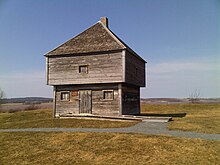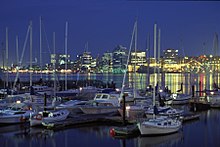New Scotland
Nova Scotia (in English: Nova Scotia, name of Latin origin; in French: Nouvelle-Écosse) and commonly abbreviated NS, is one of the ten provinces that, together with the three territories, make up the thirteen federal entities of Canada. Its capital and most populous city is Halifax. Located in the extreme east of the country, it is formed by the homonymous peninsula and the island of Cape Breton in its northern extremity. The peninsula is surrounded by the Atlantic Ocean, except for the Chignecto Isthmus, which joins it to New Brunswick, and the Northumberland Strait, which separates it from Prince Edward Island. With 55,284 km² it is the second smallest entity — ahead of Prince Edward Island — and with 17 inhab/km², the second most densely populated, behind from Prince Edward Island.
It is part of the Maritime Provinces. Its capital is a very important North American port. Fishing and tourism are vital to the province's economy.
History
Although explorer Juan Caboto visited it in 1497 on behalf of the Crown of England, Nova Scotia was first colonized by the kingdom of France. Samuel de Champlain and de Monts founded a colony on an island at the mouth of the Sainte-Croix River in 1604. Suffering from a lack of potable water on the island that winter, the following year (1605) the colony was moved to Port Royal, near of Annapolis Royal.
In 1621, King James I of England and King James VI of Scotland sent a troop of Scots to found a colony on the site under the name Nova Scotia, as a tribute to its Scottish origins. For this he founded the tax or baronetage of Nova Scotia: those who wished to obtain the noble title of baronet were obliged to pay a certain sum of money that would be used for the foundation of the colony, in addition to receiving a land grant in it. During the Nine Years' War or the Great Alliance against France, it was taken by the British, but in the treaties signed at the end of it, it was ceded back to France: Treaty of Rijswijk of September 20, 1697. Fruit of the After the treaty the Scottish colonists had to abandon it, the baronetage of Nova Scotia lost its value, becoming a mere category of nobility.
The territory was captured by British forces during Queen Anne's War, which is how the War of the Spanish Succession conflict is known in the North American scenario. English ownership was ratified by the Treaty of Utrecht (1713). France would retain possession of Île Saint Jean (Prince Edward Island) and Île Royale (Cape Breton Island), on which they established the Louisburg Fortress, which was built to monitor the shipping lanes leading to the St. Lawrence River.
The fortress of Louisbourg would be taken by the British in 1745, during the War of the Austrian Succession (1740-1748), known as King George's War in its American setting. The treaty of Aix-la-Chapelle or Treaty of Aachen (1748) that put an end to this conflict, stipulated the return to France of the fortress of Louisbourg.
Louisbourg would be taken again (Battle of Louisbourg, June-July 1758) by a mixed troop of soldiers from the British Army and inhabitants of the American colonies, during the French-Indian War, which is how the North American front is known. the Seven Years War. Once in English hands (even before the Battle of the Plains of Abraham, which would lead to the conquest of Quebec), the British destroyed the fortress of Louisbourg with explosives to prevent it from being used again by the French if it they resumed the fruit of some new peace treaty.
The English possession would be ratified by the Treaty of Paris (1763) when Great Britain received all the French territories in Canada.
The presence of French-speaking Acadians and Catholics in the territory of the future British colony posed a problem for the British regarding the colonization of the territory. In 1750 a large number of Protestant settlers, mostly of German origin, were attracted to Nova Scotia, settling on the south coast. The colony, however, remained largely Acadian. But starting in 1755, the British decided to deport the Acadians to their other American colonies, to France, the United Kingdom, or Louisiana, where many of them settled, helping to forge the Cajun culture.
After the Deportation of the Acadians, Acadian lands were given to American settlers from New England. About 8,000 of them, called "planters" settled in the colony between 1759 and 1774, among them the great-grandfather of Robert Laird Borden. A new Scottish immigration to Cape Breton Island in the late 18th century and early 19th century re-established the former Scottish presence in the region.
In 1784 the northwestern mainland portion of the colony was separated from the rest, becoming the colony of New Brunswick.
In 1848 Nova Scotia became the first colony of the British Empire to achieve self-government, in which the British governor was obliged to accept decisions made by a Legislative Assembly and by ministers elected by the same.
Many of those who died in the sinking of the RMS Titanic are buried on the island.
Nova Scotia became, upon entering the Canadian Confederation, one of the four founding provinces of Canada, along with New Brunswick, Quebec (Canada East) and Ontario (Canada West ).
Despite its name, there are very few people left in the region who continue to speak Scottish Gaelic, although Celtic music is still very popular on Cape Breton Island. There is still a small Acadian presence in the town of Clare (west of the province) today.
Administrative division
The province is divided into 18 counties. In 2016, 50% of the population is Protestant and 30% Catholic.
The 10 most populous counties in the province:
| County | 2006 | 2011 |
| Halifax County | 372 858 | 390 328 |
|---|---|---|
| Cabo Bretón County | 105 928 | 101 619 |
| Kings County | 60 035 | 60 589 |
| Colchester County | 50 023 | 50 986 |
| Lunenburg County | 47 150 | 47 313 |
| Pictou County | 46 513 | 45 643 |
| Hants County | 41 182 | 42 304 |
| Cumberland County | 32 046 | 31 353 |
| Yarmouth County | 26 277 | 25 275 |
| Annapolis County | 21 438 | 20 756 |
Economy
Nova Scotia's economy is currently based on the service sector and the industrial sector, although the primary sector continues to maintain a presence.
Agriculture, livestock and fishing
In the primary sector, with regard to agriculture, the production of fruit stands out, especially apples and potatoes. Poultry and pig farming is present in the livestock, to which is added a bovine herd that generates dairy products.
There is also an active forestry-type industry, dedicated to the exploitation of the territory's forests.
On the other hand, it is equally important to fish for lobsters, bivalves (especially scallops) or cod, especially.
Industry
It also has an active industry, related to fishing activities and the food industry in general, but also the paper industry, transport equipment.
Tertiary sector
Tourism has acquired increasing importance throughout the second half of the 20th century.
Universities
- Acadia University
- Atlantic School of Theology
- Cape Breton University
- Dalhousie University
- Mount Saint Vincent University
- Nova Scotia Agricultural College
- NSCAD University
- Saint Mary’s University
- St. Francis Xavier University
- Université Sainte-Anne
- University of King’s College
Contenido relacionado
Holland
Atlantic Ocean
Olive groves



